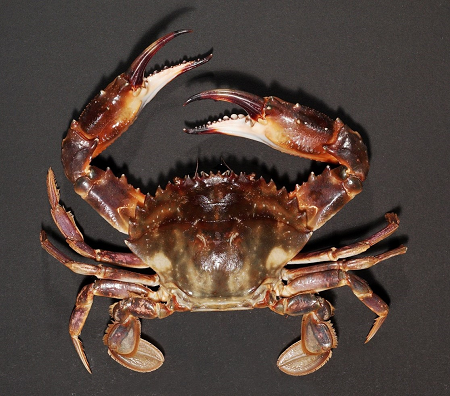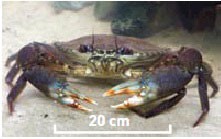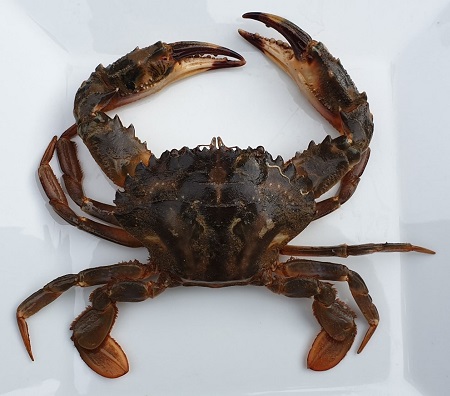Asian paddle crab (Charybdis japonica) is an aggressive marine predator that could out compete native crabs and can carry white spot syndrome virus. This can affect native and farmed prawns, crabs and lobsters.
What to look for
Features:
- red, purple, orange to pale green and off-white shell
- 5 distinct spines on upper surface of foreclaw
- 6 spines to sides of eyes
- swimming paddles on last set of legs
- shell up to 12cm wide.
Where to look
Look in or around:
- mud
- sand.
Likely habitats include:
- shallow waters to 15m deep.
Similar native species
These native species look similar to Asian paddle crab. They do not need to be reported.
Pacific swimming crab (Charybdis helleri)
Features:
- 4 spines on foreclaw
- 6–8 spines to sides of eyes
- shell up to 14.5cm wide.
Habitat:
- mud
- sand
- rocks and coral (including underneath)
- lower shores and shallow waters, up to 30m deep.
Known locations are Northern Territory, central east and north–east coast Queensland, north–west Western Australia.
Blue swimmer crab (Portunus pelagicus)
Features:
- bright blue legs and claws
- no spines to sides of eyes
- shell up to 21cm wide.
Habitat:
- sheltered sand
- shores and shallow waters, up to 70m deep.
Known locations are across northern Australia from Cape Naturaliste, Western Australia, to Eden, New South Wales and South Australian gulf.
Mud crab (Scylla serrata)
Features:
- large robust claws
- 9 spines to sides of eyes
- shell up to 25cm wide.
Habitat:
- tidal flats
- mangroves
- sheltered areas.
Known locations are northern Australia from Exmouth, Western Australia to Bega River, New South Wales, isolated records from Mallacoota estuary, Victoria, Swan River, south-west Western Australia estuaries.
Report it
See something unusual? Report it. Even if you’re not sure.
If you see something you think is a pest:
- note the exact location (screenshot your map app or enable photo geotagging on your phone)
- take a photo (use something for size reference, like a coin or note)
- contact your state or territory authority.
Stop the spread of marine pests
Start with these simple steps:
- Inspect and clean your boat or yacht. Make sure you check hard to reach areas.
- Treat the hull of your boat or yacht regularly.
- Clean and dry your fishing and diving gear after every use.
How you can stop the spread of marine pests.
Your location
The map shows known pests and pests to look for around Australia.






